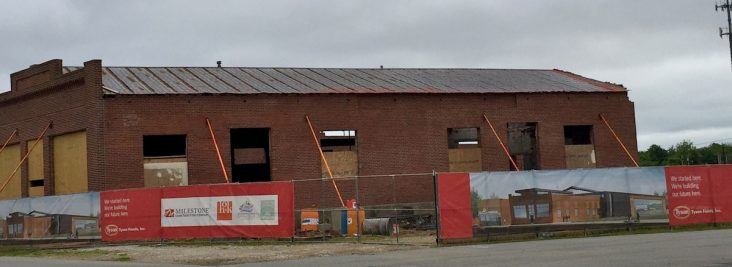Economics, investing in people reasons behind downtown improvements in Fayetteville, Siloam Springs, Springdale
by May 18, 2016 4:54 pm 285 views

Renovations continue on a building owned by Tyson Foods on Emma Avenue in downtown Springdale. More than 200 people will work in building when it's completed later this year.
Editor’s note: This is the second of two stories about numerous public and private investments in Northwest Arkansas’ downtowns in recent years. Link here for the first article.
––––––––––––––––
Siloam Springs, Springdale and Fayetteville are all in the midst of major quality of life improvements and leaders from each city say it will benefit current residents as well as encourage economic development.
Much of the investments have been in the respective cities’ downtown areas and the money invested has largely come from dedicated sales tax, bond issues, and other budget line items.
In Siloam Springs, a downtown revitalization plan has been in place since 2014, but until March, the plan did not have a dedicated funding source. Meredith Bergstrom, executive director of Main Street Siloam Springs, said the agency advocated for a sales tax extension that required voter approval in March. They helped the public understand why the sales tax was still necessary, and the specific changes that were made to how the revenue would be spent. The city has a $35,000 contract with Main Street that requires annual approval. The goal is preserve the history that is already there while investing in further development and creating events that invite the community at large to downtown.
Previously, the 3/8 cent sales tax went to general capital improvements. After it was renewed, half the revenue will stay with capital improvements and the other half is dedicated to specific downtown improvements within the revitalization plan. This includes trails, sidewalks and other improvements.
“This is a major step forward,” she said, adding that the sales tax renewal passed with a high majority approval. “The community knew what it was voting for and the importance of that.”
In 10 years, the 3/8 cent sales tax is expected to generate a conservative $14 million with $7 million going toward downtown improvements. With other entities investing, the total downtown investment is $10 million.
The belief is – and statistical evidence found in the city’s Downtown Dashboard report already shows – that investing in downtown encourages economic growth and is far more than simple beautification. Bergstrom said that the amount of tax dollars per acre in downtown had quadrupled in recent years.
Earlier this month, Main Street Siloam Springs announced a bank loan consortium that will provide $2.5 million in seed money for small businesses seeking to renovate or open a business in the city’s downtown and within the parameters of the city’s master plan.
SPRINGDALE INVESTMENTS ADDING UP
Various attempts to revitalize downtown Springdale have finally come into fruition in the last year. A new Master Plan was approved recently and the Downtown Springdale Alliance is working closely with the city to make major changes over the next 15 to 20 years.
The city’s investment started before the master plan received approval, however. The city invested about $250,000 to build public restrooms in downtown, Mayor Doug Sprouse said. Other improvements – totaling $2.5 million – have included:
• Lighting upgrade to LED for Emma and Shiloh Square with an energy block grant;
• Purchase and renovation of buildings at 128-132 Spring Street for city departments;
• Purchase and removal of two building 100 E Emma and 125 Mill Street for Walter • Turnbow Park;
• The Meadow Street Trail; and
• The expanded downtown master plan.
Sprouse said the city estimates it will spend an additional $2 million over the next couple of years for streetscapes and utility upgrades. That figure does not include upgrading water and sewer infrastructure along Emma, which will be done by Springdale Water Utilities.
Sprouse attributes the success of the most recent revitalization efforts largely to the Razorback Greenway.
“Downtown has struggled for years,” he said. “The Greenway is what made this click. It’s helped us make a case to create something downtown. There was already a connection between quality of life and economic development that not everyone saw.”
Springdale also has a contract with the Springdale Chamber of Commerce and the Downtown Springdale Alliance to provide programming and planning for the downtown area. The area is becoming more active with community events including the spring Little Craft Show and the new Mill Street Farmers Market.
FAYETTEVILLE BUILDS ON ‘ECLECTIC ASSORTMENT’
Fayetteville has a history of investing in quality of life for its residents, guests, and potential new economic development. Mayor Lioneld Jordan said the city has made quality of life investments in physical infrastructure (roads, sidewalks, parks), digital infrastructure (expanded broadband), and social infrastructure (example: first city in Arkansas to host a city-wide Black History celebration).
Jordan said the city is filled with an eclectic assortment of people from different backgrounds, beliefs and needs. By focusing on investing in people and their needs, the city has been able to establish a platform that focuses on enhancing quality of life.
Instead of focusing directly on downtown, Fayetteville has focused on what is known locally as “the Mayor’s Box,” which literally forms a box on the city map. The improvements have included the soon-to-open $11 million regional park, major road and utility improvements ($65 million), bike lanes, trails, a new parking garage, constructing the Fayetteville Flyover, and assisting the Walton Arts Center with its major expansion efforts. All of the endeavors are expected to bring additional economic development to the downtown region and beyond, Jordan said.
“When you’re investing in people, you have to have a good economic engine,” Jordan said. “It’s all about people. We believe in a partnership-based government.”
